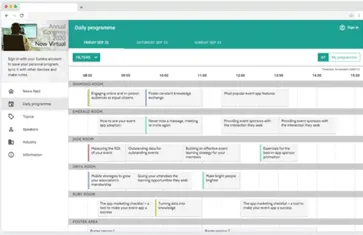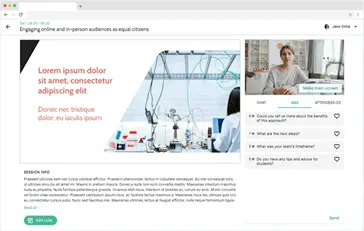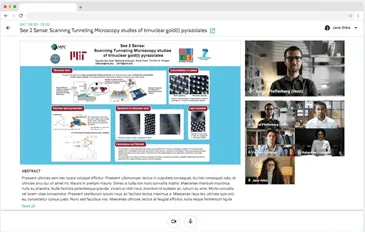Keynote and plenary talks from renowned speakers
Meet the esteemed committee members and speakers participating in the conference.

Unfortunately we don't fully support your browser. If you have the option to, please upgrade to a newer version or use Mozilla Firefox, Microsoft Edge, Google Chrome, or Safari 14 or newer. If you are unable to, and need support, please send us your feedback.
We'd appreciate your feedback.Tell us what you think! opens in new tab/window
11-12 November 2022 | Online — Live and On-demand

Join us live for the first AI in Aging and Age-related Diseases Conference:
Participate in a new international conference looking at the impact of AI and data-driven technologies within the research scope of major diseases and disease management related to aging
Hear invited talks from international experts in the field: Live-stream presentations and take part in discussion through live chat and Q&A — plus enjoy 6 months on-demand post event access to recorded sessions*
Present your work as a poster at this important event
*On-demand access includes recordings of talks and slides, poster pitches and posters from authors that have agreed for post event distribution: the organizers cannot guarantee on-demand access to all presentations.
Meet the esteemed committee members and speakers participating in the conference.

The new era of digital medicine is data-driven and AI-enabled. The emergent computational methods and innovative hardware, software, and sensors implementations for artificial intelligence will impact the entire spectrum of healthcare delivery and disease management. Coupling with the trends of aging population worldwide, this timely conference on AI in Aging and Age-related Diseases aims at understanding the value and the interplay of these technologies within the research scope of neurological disorders related to aging from an interdisciplinary perspective.
The conference addresses the processes in prevention, detection, diagnosis, treatment, and follow-up care of age-related neurological disorders such as Alzheimer’s Disease and Related Dementias, Parkinson’s Disease, Strokes, Epilepsy, Brain Tumor, Polyneuropathy, and Myopathy. It explores the state-of-the-art of interdisciplinary insight, addresses the trade-offs that occur — and synergies that can be sought — in treating neurological disorders related to aging. Contributions which bridge themes or scales, foster interdisciplinarity and integration or address interactions between clinicians, neurosurgeons, neuroscientists, aging care service providers, AI designers, computer scientists, imaging specialists, and biomedical engineers are particularly welcome.
Successfully submitted abstracts will be acknowledged with an electronic receipt including an abstract reference number, which should be quoted in all correspondence. Allow at least 2 hours for your receipt to be returned to you.
Once the paper is accepted, at least one of the authors must register for the conference and present the paper at the conference.

This conference is organized by Elsevier in association with Tongji University.
Our high-quality online platform will maximize exposure of all research and encourage interaction and discussion for all presenters.
Deliver a talk and answer questions from other attendees during live Q&A
Present your poster in live poster sessions
Include a short video pitch to summarize your research then discuss your work with other attendees during the live event
Enjoy access to recordings of talks and posters for 6-months post event*
Participate live from your desktop or mobile device to:
Deepen your knowledge: Live-stream a personalized schedule from the entire program to match your research interests.

Engage with our inspirational speakers and other attendees during the live-streamed sessions: Ask questions and participate in live chat and polls.

Review the latest research in the ePoster hall and discuss directly with the author in the live poster sessions.

Plus:
Network with your peers, meet new contacts and renew relationships: Connect with other attendees during the live event to chat and arrange one-to-one meetings
Discuss your research with a wider, more-inclusive audience: our online poster sessions enable the author and delegates to engage directly in small groups during the live sessions
Visit the live exhibition booths to meet industry partners, chat with exhibitors and learn more about their products
Enjoy more flexibility with on-demand access to recorded sessions for six months after the event*
Watch one stream live and catch-up on what you missed after the event
*On-demand access includes recordings of talks and slides, poster pitches and posters from authors that have agreed for post event distribution: the organizers cannot guarantee on-demand access to all presentations.
Aging and Health Research (AHR) opens in new tab/window is an international, peer-reviewed open access journal that publishes articles from a global research community. The aims of this journal is to establish an innovative forum of global aging and health research to advance knowledge in diverse disciplines to promote early detection, diagnosis, treatment, and intervention of chronic diseases; to disseminating knowledge for optimal translation of research findings into policy and practical settings; to communicate new ideas, findings, perspectives, and research directions; to advocate public policies promoting aging and health in a global context.

The purpose of the journal Computerized Medical Imaging and Graphics opens in new tab/window is to act as a source for the exchange of research results concerning algorithmic advances, development, and application of digital imaging in disease detection, diagnosis, intervention, prevention, precision medicine, and population health.

Mechanisms of Ageing and Development opens in new tab/window is a multidisciplinary journal aimed at revealing the molecular, biochemical and biological mechanisms that underlie the processes of ageing and development in various species as well as of age-associated diseases.

NeuroImage opens in new tab/window, a Journal of Brain Function, provides a vehicle for communicating important advances in the use of neuroimaging to study structure-function and brain-behavior relationships. Though the emphasis is on the macroscopic level of human brain organization, meso-and microscopic neuroimaging across all species will be considered if they provide advances that are of relevance to a systems-level understanding of the human brain.

NeuroImage: Clinical opens in new tab/window, a companion title to the highly-respected NeuroImage, is a journal of diseases, disorders and syndromes involving the Nervous System, provides a vehicle for communicating important advances in the study of abnormal structure-function relationships of the human nervous system based on imaging.

Pattern Recognition opens in new tab/window is a mature but exciting and fast developing field, which underpins developments in cognate fields such as computer vision, image processing, text and document analysis and neural networks. It is closely akin to machine learning, and also finds applications in fast emerging areas such as biometrics, bioinformatics, multimedia data analysis and most recently data science. The journal Pattern Recognition was established some 50 years ago, as the field emerged in the early years of computer science. Over the intervening years it has expanded considerably.

Abstract submission (talks and posters): 10 October 2022
